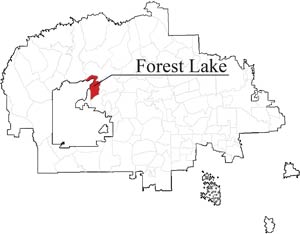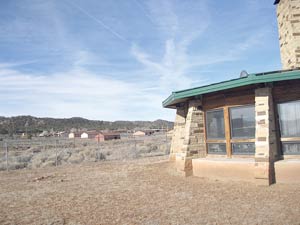Home of the fighting grannies
Forest Lake residents resisted mining, relocation
By CIndy Yurth
Tséyi' Bureau
FOREST LAKE CHAPTER, Ariz., March 21, 2013
(Editor's note: In an effort to chronicle the beauty and diversity of the Navajo Nation, as well as its issues, the Navajo Times has committed to visiting all 110 chapters in alphabetical order. This is the 27th in the series.)


(Times photo — Cindy Yurth)
The 15-year-old, hogan-shaped senior citizens center is a short walk from a Navajo Housing Authority subdivision. A van also picks up seniors from throughout the chapter for the daily hot lunch.
Y ou could think of this chapter as perhaps the most heavily impacted by recent events.
Mining on Black Mesa has displaced many of its families, and the chapter lost much of its land area in the Navajo-Hopi land dispute. Some elders say pumping the Navajo Aquifer to slurry coal to Nevada has dried up the little springs and washes on which traditional herders and their livestock used to depend.
When the wind whips up, coal dust from the mine settles on nearby homes. Much of the chapter was under the "Bennett Freeze" — freezing any kind of development — until the land dispute was finally settled by the Navajo and Hopi tribes in 2009.
So you could think of this beautiful chapter in the middle of the Navajo Nation as a sad place. Or, you could think of it as Malcolm Benally does: the heart of the resistance.
The place where a handful of older women, with little formal education and limited English, fought a multi-national corporation, the United States and their own tribal government — and, briefly, appeared to be winning.
When Benally — a Forest Lake native who wrote the acclaimed oral history compilation "Bitter Water" — thinks of his home chapter, he thinks of Maxine Kescoli.
"She put in a lawsuit, and managed to shut down the (Kayenta) mine for two months," Benally said.
According to the court documents in Dineh Alliance and Maxine Kescoli v. Office of Surface Mining and Peabody Western Coal Co., the OSM had renewed Peabody's permit to mine coal on Black Mesa on July 6, 1995.
Kescoli and the environmental group Dineh Alliance filed suit, claiming the company planned to mine within 300 feet of Kescoli's home without her permission and had already disturbed Navajo and Anasazi burial sites in violation of the Surface Mining Control and Reclamation Act.
The crux of the argument presented by Kescoli's DNA attorney was that, although the land was tribal land held in trust by the U.S. government, Kescoli and the other customary land users in the path of the mine should be thought of as "surface owners," and have the same rights under the law as do the owners of mined land off the reservation.
Administrative Law Judge Ramon Childs agreed, writing in his March 11, 1996 decision: "The Navajo Nation with the consent and approval of the Bureau of Indian Affairs (BIA) appears to have entered into a mineral lease which does not treat the rights of the surface occupants."
Kescoli's victory was brief; Peabody was allowed to resume mining in May pending its appeal, and on Oct. 16 another administrative law judge overturned Childs' ruling. Both the Navajo and Hopi tribes had filed intervening briefs siding with Peabody.
Still, Benally said, "that was probably the highlight of the relocation struggle," which continues today with a handful of aging matriarchs refusing to budge from what is now Hopi Partitioned Land.
Benally is convinced the government holds hearings on environmental impact statements and the like in "Shonto, Flagstaff, Kayenta, anywhere but Forest Lake" because it's afraid of the Forest Lake grannies.
The 43-year-old remembers when, as a child, he watched the partition fence go up right down the middle of his parents' cornfield. Suddenly, a good portion of former Forest Lake Chapter residents were living on Hopi land. They could choose to move into new homes the government built for them on the Navajo side, or stick it out in violation of the court order.
"It creates problems for us," sighed Benally's aunt, Chapter Services Coordinator Ella Benally. "We still think of them as part of us, but we're not supposed to provide them services."
There are other jurisdictional issues: almost equidistant from service centers in Chinle, Hopi, Tuba City and Kayenta, "It seems like we should be getting all these services," Ella Benally said, "but, for instance, we're right at the intersection of three or four NTUA districts, and it's never clear who we're supposed to go to."
If you call 911 from Forest Lake (assuming you can get cell phone service, which is spotty), the call goes to Kayenta. But then, according to Ella Benally, the dispatcher in Kayenta calls the Chinle Police District to dispatch an officer.
The coalmines on Black Mesa, while they have disrupted lives, do provide some services that wouldn't be available otherwise. Forest Lake residents can get water and coal from Peabody, and use the company's transfer station for dumping household garbage.
The company once donated a grader to the chapter, and Peabody plows the school bus routes in the winter. Peabody distributes red dog gravel, a by-product of its mining operations, to a coalition that includes representation from Navajo County, Navajo Department of Transportation, the Bureau of Indian Affairs and surrounding chapters, who meet regularly and decide which roads to put it on.
While the Black Mesa Mine shut down in 2005, the remaining Kayenta mine still employs a fair chunk of Forest Lake's population, Ella Benally said.
Peabody "even helps us with our Christmas dinners," she added, and many chapter residents have attended college on Peabody scholarships.
Perhaps because they have had to deal with the consequences of development for so many years, Forest Lakers, says Ella Benally, are particularly resistant to change.
"When we had community meetings for the land use plan," she said, "most of the people didn't want economic development. The people tell us, 'Keep it simple; let's stay a ranching community.' You hear the words 'conservation' and 'restoration' a lot more than you hear 'development.'"
Both Benallys point out Forest Lake is rich in Navajo medicinal plants that need to be protected — and if traditional knowledge were a commodity, Forest Lake would be one of the richest chapters of all.
Still, the community has extended electricity to all but its most remote homes, and the new Manymules Water Project will provide running water to about 80 people.
The chapter has Internet service from Sacred Wind, and a new NTUA tower will improve cell phone reception if they ever connect it.
"They were supposed to turn it on in February," Ella Benally said, "So we should be getting it soon."
There's talk of paving the Turquoise Trail from Hopi and the road to the coal mine, both of which would make Forest Lake that much more accessible to the outside world. Eventually, Ella Benally believes, the community will develop.
"It would be nice to have schools, hospitals, shops, recreation," she said. "But that's a hundred years down the road. For now, we like the quiet."
Forest Lake at a Glance
Name — According to Malcolm Benally, there was once a fairly large reservoir on the plateau where the town is laid out. "Forest Lake" is almost a literal translation of the Navajo name, "Tsiyi' Be'ak'id," "Pond between the trees."
Population —471 according to the 2010 U.S. Census; Chapter Services Coordinator Ella Benally estimates it at 2,500 to 3,000 "including the kids"
Assets — strong elders, medicinal plants, coal
Problems — relocation, loss of land to the Hopis, Bennett Freeze

